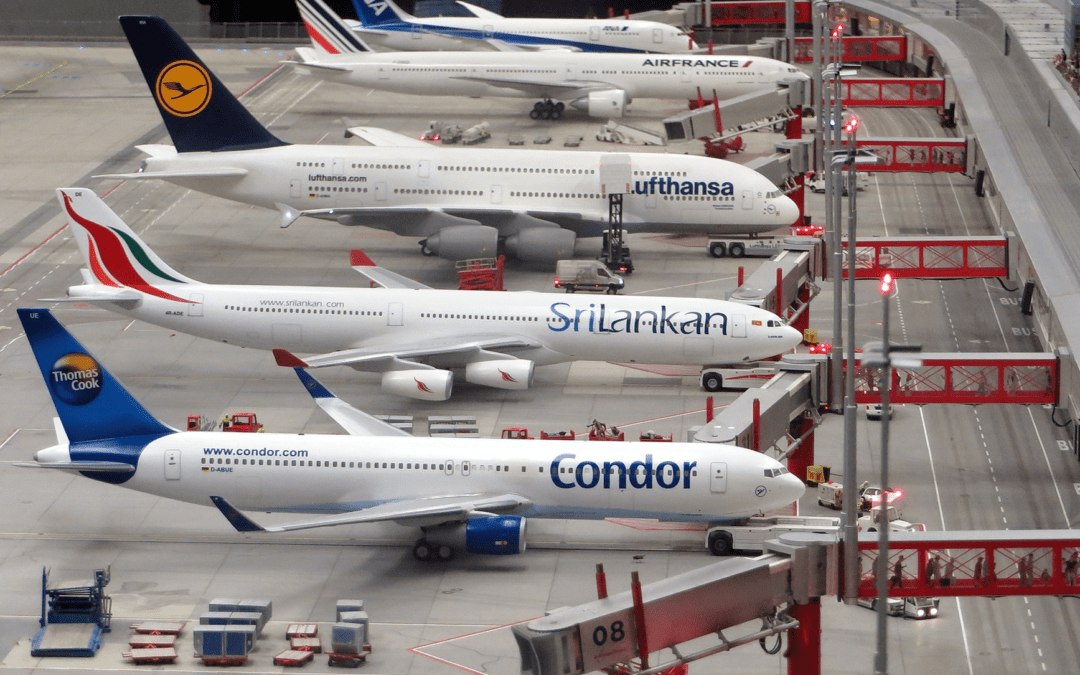The aviation industry is placing increasing demands on the properties of aluminum alloys used for aircraft manufacture. Grain refinement is one way to improve the strength and ductility of aluminum alloys. Integrated analysis solutions, like the Clemex Vision PE, make observing and quantifying the effects of grain refinement quick and easy.
Aluminum is a vital metal in the aerospace industry; in fact, the majority of aircraft parts including the fuselage, wings, and supporting structures are constructed from aluminum alloys. Aluminum alloys are so popular because they are lightweight and low cost. They are also easy and cheap to manufacture and shape. What’s more, the properties of aluminum alloys can be adjusted to meet the demands of specific applications throughout the aircraft. It’s not surprising, then, that aluminum and its alloys have been the dominant material in aircrafts for the past century.1,2,3
Globalization has resulted in an increased demand for aircrafts and aluminum alloys. However, the aviation industry doesn’t just need more planes. It needs cheaper planes that are less expensive to run and easier to maintain, so that savings can be passed on to the consumer with lower ticket prices. Increased environmental awareness and increasingly stringent regulations also drive demands for increased fuel efficiency, lower emissions, and reduced environmental impact.1,4
Better materials mean cheaper planes with reduced emissions
Improving material performance is one way to reduce aviation costs and environmental impact. Stronger, more durable and corrosion resistant materials also provide reductions in maintenance costs and increase lifespan.4
To keep up with the demands of the aviation industry, and compete with new materials such as composites, it is crucial to design better aluminum alloys. This was recognized by the European Commission in 2015 when they issued the European Metallurgical Roadmap of 2050 which aims to support the development of aluminum alloys with improved strength, formability, and corrosion resistance.6
The performance and specific properties of aluminum alloys depend on their composition and microstructure. Over the past few decades, various methods have been developed to improve the performance properties of aluminum including alloying, cold working, purification, and heat treatments. However, grain refinement is one of the most successful methods of improving the strength and plasticity of aluminum alloys and has become common industrial practice.1-5
Grain refinement improves aluminum performance
Grain size is one of the key microstructural factors that affect the properties of aluminum alloys. Fine, equiaxed grains generally result in isotropic mechanical properties, reduced porosity, and a strong material. Grain size can be reduced by a process called grain refinement. Grain refinement relies on recrystallization, which can be achieved thermally, mechanically or chemically.7,8
Thermal methods of grain refinement involve controlling the cooling rate of molten aluminum alloys during manufacture to influence nucleation and grain growth. Mechanical methods of grain refinement use agitation to limit grain growth during cooling and solidification.7,8
Chemical grain refinement methods involve adding a grain refining additive, commonly titanium and/or boron master alloys, before casting. Grain refining additives increase nucleation and prevent grain growth, resulting in smaller grain sizes.
The amount, form, size, and quality of additives influence the final grain size and structure of the alloy. Chemical grain refinement is regarded as the most effective way to achieve fine, uniform grains and is the most widely used method.7,8,9
Observing the effects of grain refinement
Examining the microstructure and grain characteristics of aluminum alloys allows manufacturers to observe the effects of refinement on grain structure, determine which methods of grain refinement are most successful, and optimize process conditions. Measuring grain size and analyzing grain uniformity can give numerical indications of the effectiveness of grain refinement.10
Microstructure analysis is typically conducted using a microscope to observe the grains in the finished aluminum alloy. Many quality control laboratories estimate grain size by comparing the grains seen through the microscope with a chart. However, this method involves estimation by an operator and can be inaccurate.
What’s more, there is no observation of grain size distribution. Grain sizes can be measured manually, but this process is very time-consuming. The easiest, quickest and most reliable way to measure grain size and observe other grain characteristics is to use an advanced image analysis solution, such as the Clemex Vision PE.10-13
Software that accurately detects grain boundaries for high-throughput grain characterization
The Clemex Vision PE is a vital tool for grain characterization in aluminum alloy research for the aerospace industry. Clemex Vision image analysis is used by researchers around the world to provide accurate and reliable grain size measurements of aluminum alloys.9,14-16
Polarized microscopy and color filters allow the Clemex Vision PE to discriminate all grains and accurately analyze grain size, shape, and distribution automatically (see Figure 2).12,13,17
Figure 2: Original image of anodized aluminum observed with color filters (left), the image with automatically detected grain outlines overlaid (centre), grain size distribution (right).17
However, the Clemex Vision PE is not just for aluminum alloy research; it provides the ideal multipurpose image analysis system for metallurgy research laboratories. It is flexible and efficient, but easy to use.
The Clemex Vision PE delivers a range of accurate analyses relevant for metallurgical research including dendrite arm spacing, layer thickness, grain size, surface roughness, phase percentage, and unlimited custom image analyses. What’s more, the high-throughput system allows you to leave the lab and be confident that you will come back to clear reports and useful, high-resolution data.
References and further reading
- ‘A review on the use of aluminium alloys in aircraft components’ — Yashpal K, Jawalkar CS, Kant S, Journal on Material Science, 2015.
- ‘Aluminum – Specifications, Properties, Classifications and Classes’ https://www.azom.com/article.aspx?ArticleID=2863
- ‘Aerospace Materials and Material Technologies’ — Eswara Prasad N, Wanhill RJH, Springer, 2017.
- ‘Innovation in Aerospace’
https://www.raeng.org.uk/publications/reports/innovation-in-aerospace
- ‘Introduction to Aerospace Materials’ — Mouritz A, Woodhead Publishing, 2012.
- ‘Metallurgy’
https://ec.europa.eu/research/industrial_technologies/pdf/metallurgy-made-in-and-for-europe_en.pdf
- ‘Recent advances in grain refinement of light metals and alloys’ — Easton MA, Qian M, Prasad A, StJohn DH, Current Opinion in Solid State and Materials Science, 2016.
- ‘A Review on Grain Refinement of Aluminum Alloys: Progresses, Challenges and Prospects’ — Guan RG, Tie D, Acta Metallurgica Sinica, 2017.
- ‘Optimum grain refining with a high performance master alloy’ — Vainik R, Courtenay J, Byrant M, Aluminium Today International, 2009.
- ‘Aluminum Properties and Physical Metallurgy’ — Hatch JE, ASTM International, 1984.
- ‘ASTM E112-13 Standard Test Methods for Determining Average Grain Size’ —ASTM International, 2013.
- ‘Clemex Vision PE: The most complete image analysis solution’
https://www.clemex.com/en/Products/Multipurpose-Image-Analysis/Clemex-Vision-PE/Description
- ‘The most complete image analysis solution’
- ‘Effect of grain refinement on mechanical properties and sliding wear resistance of extruded Sc-free 7042 aluminum alloy’ —Vasheghani Farahani M, Emadoddin E, Emamy M, Honarbakhsh Raouf A, Materials & Design, 2014.
- ‘Mechanical Properties and Microstructural Characteristics of Friction Welded Dissimilar Joints of Aluminium Alloys’ — Sundara Bharathi SR, Rajeshkumar R, Razal Rose A, Balasubramanian V, Transactions of the Indian Institute of Metals, 2018.
- ‘Transient Liquid Phase Bonding of AA-6063 to UNS S32304 Using Cu Interlayer’ —Saleh MI, Khan TI, Roven HJ, Procedia Chemistry, 2016.
- ‘Grain Size Characterization in Aluminum Alloys’ https://www.clemex.com/clemex/media/assets/pdf/Applications/Image-Analysis-Reports/130_Aluminium_GrainSize.pdf?ext=.pdf


